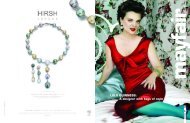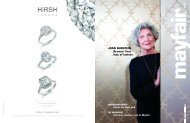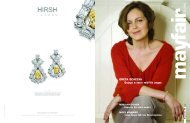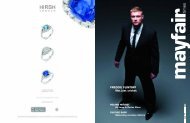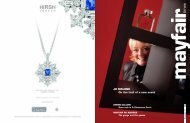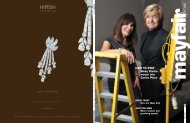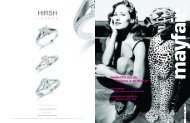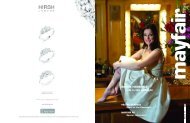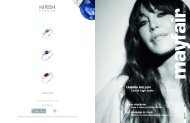JERMAIN DEFOE Thinking On His Feet - Mayfair Times
JERMAIN DEFOE Thinking On His Feet - Mayfair Times
JERMAIN DEFOE Thinking On His Feet - Mayfair Times
You also want an ePaper? Increase the reach of your titles
YUMPU automatically turns print PDFs into web optimized ePapers that Google loves.
14 15<br />
art<br />
True<br />
colours<br />
In May 2005, the celebrated Colour Field painter Frank<br />
Bowling became the first black Royal Academician. <strong>His</strong><br />
election was a landmark in the Royal Academy’s 239year<br />
history, and a long-awaited sign of recognition for<br />
the artist. “It was 40 years coming,” says Frank, “but<br />
when it did come it blew me away.”<br />
Born in Guyana in 1936, Frank came to London<br />
when he was 15. <strong>His</strong> interest in art began in 1953<br />
when, as a teenager completing his National Service in<br />
London, he explored the National Gallery and Victoria<br />
and Albert Museum. “I knew nothing about drawing or<br />
painting, but I was hooked,” he says.<br />
Several years and various art schools later, he<br />
graduated from the Royal College of Art, alongside<br />
David Hockney, R B Kitaj, Allen Jones and Derek<br />
Boshier. The year was 1962.<br />
Things went well, and in 1964 he exhibited at The<br />
London Group exhibition at the Tate Gallery. But then<br />
everything went quiet. Excluded from British group<br />
shows and under pressure to exhibit at the first World<br />
Festival of Negro Art in Senegal, he began to feel<br />
“distressed”.<br />
“I started feeling that what I was having to deal with<br />
was the ‘black artist’ tag,” he says. “I wasn’t just an<br />
artist or a British artist: I’d been pigeonholed, and it<br />
began to really worry me. How does somebody like<br />
me, being black, leap over these hurdles? There<br />
seemed to be no way.”<br />
For the next few years he travelled between<br />
London and New York in a bid to find “circumstances<br />
that would allow me to flower”. He was met with<br />
resistance. And, although a fellowship at the<br />
Guggenheim Museum in New York in 1967 gave him a<br />
solid, more confident footing in America, he still felt<br />
stifled by the “black artist” label.<br />
Around that time, he was approached by the Art<br />
Magazine to come on board as a writer – an offer<br />
Frank saw as “an opportunity to express myself about<br />
what was happening to black people in the art world.<br />
“I went in to bat for them,” he adds, “and also for<br />
myself, of course.<br />
“It was a very peculiar time,” says Frank of his<br />
writing days. “There was a feeling among the black<br />
artists that I wasn’t for real. You know, ‘How can a guy<br />
who paints also write?’ sort of thing. They were cruel.<br />
Always suspicious. But I stuck it.”<br />
A solo show at the Whitney Museum in New York in<br />
1971 presented a welcome interruption to the drought<br />
of exhibitions of his work. “And then I got lucky,” he<br />
says. “I met Clement Greenberg.”<br />
Frank forged a strong friendship with the renowned<br />
American art critic, simultaneously absorbing<br />
Greenberg’s thoughts on abstract art and modifying his<br />
own painting style and approach.<br />
“In 1971, I became an abstract artist,” Frank says<br />
matter-of-factly. Attracted by the structure that was<br />
central to abstract art, he created works that combined<br />
vivid colour with strict geometry. Then, in the mid-<br />
Seventies, he went on to experiment with his poured<br />
paintings, to which his current show at The Arts Club<br />
in <strong>Mayfair</strong> is dedicated.<br />
The poured paint series was an experimental time<br />
for Frank, when he explored “the conjunction of<br />
chance with structure”. Although nervous about their<br />
direction, he felt he was “on the right track… And, as I<br />
got more confident, the paintings became what they<br />
are now.”<br />
<strong>His</strong> mature works combine the vibrancy of palette<br />
of his early Colour Field paintings with seemingly<br />
mundane plastic objects such as jam-jar tops and<br />
vitamin-pill containers, which are embedded into the<br />
canvas. “I chuck these things in because I feel they’re<br />
part of my life,” he explains. “All these works serve as<br />
an autobiography. It’s my life and everything that<br />
concerns me goes in.”<br />
Based on this premise, his paintings from the past<br />
two years should be pretty exciting. Since his election<br />
to the Royal Academy, Frank has been taken on by<br />
ROLLO Contemporary Art – the curator of The Arts<br />
Club show – and there is a second solo exhibition of<br />
his works running simultaneously in New York. He<br />
recently held a solo show at the academy. And he will<br />
take part in a public “conversation” with the art critic<br />
Mel Gooding at the Tate Britain on May 9.<br />
Frank is also on the selection and hanging<br />
AFTER YEARS OF<br />
RELATIVE OBSCURITY,<br />
FRANK BOWLING IS<br />
FINALLY GAINING<br />
THE RECOGNITION HE<br />
HAS LONG CRAVED.<br />
ELECTED THE<br />
FIRST BLACK ROYAL<br />
ACADEMICIAN IN 2005,<br />
THE 71-YEAR-OLD<br />
ARTIST IS NOW<br />
BEING CELEBRATED<br />
IN A SERIES OF<br />
INTERNATIONAL<br />
SHOWS. SOPHIE<br />
BISHOP MEETS HIM<br />
PANDORA’S BOX, 1975<br />
committee for this year’s Summer Exhibition at the<br />
Royal Academy – a process he has found somewhat<br />
draining. “But I love being a member of the RA,” he<br />
adds, “and I hope and trust that my energy sustains.<br />
“I’m in my 70s, and I do feel that this new situation,<br />
whereby I’m showing work in England more and more,<br />
tends to be hard on my diminishing resources as a<br />
human being. My mental and physical energy is being<br />
taxed and I hope I don’t fall off the edge of the world<br />
before I’m really satisfied with how things are going.<br />
“If I had a big wish to whoever makes one’s wishes<br />
come true, it would be that over the next short while<br />
things will become satisfactory so that I feel I’ve<br />
achieved whatever it is that I first set out to achieve.”<br />
As I am leaving Frank’s Pimlico flat – a stone’s<br />
throw from Tate Britain – he airs a second big wish:<br />
that someone, somewhere in England will see right<br />
and give him a much deserved and long-awaited<br />
retrospective exhibition.<br />
Frank Bowling: Poured Paintings runs until June 1<br />
at The Arts Club, 40 Dover Street, <strong>Mayfair</strong>.<br />
T 020 7499 8581. View by appointment only.




